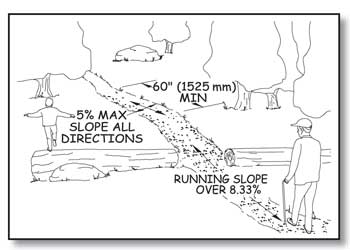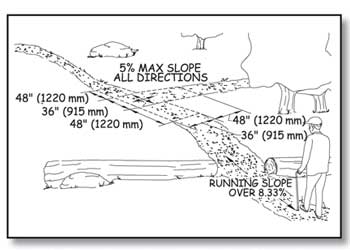Resting Intervals on Trails
Resting intervals are relatively level areas that provide an opportunity for people to stop and catch their breath. Provide resting intervals between each trail segment any time the running slope exceeds 1:20 (5 percent) as shown in table 5. Ensure that the resting interval is at least 60 inches (1,525 millimeters) long and at least as wide as the widest segment of the trail tread leading into it, if the resting interval is within the trail (figure 132). If the resting interval is beside the trail, ensure that it is at least 60 inches (1,525 millimeters) long and at least 36 inches (915 millimeters) wide. If the resting interval is adjacent to the trail tread, provide a turning space complying with ABAAS section 304.3.2. This doesn't mean that another space must be provided for turning around or as a passing space in addition to the resting space. The resting space itself may also serve as the turning and passing space if it is at least 60 inches (1,525 millimeters) in diameter or is T-shaped with a minimum 60- by 36-inch (1,525-by 915-millimeter) arm and a minimum 36-inch (915-millimeter) -wide by 24-inch (610-millimeter) -long base (figure 133).
Design Tip
The cross slope requirement depends on what material is used.
Those who use a manually operated wheelchair or a walker know that as cross slope increases, travel becomes more difficult. This is because working against the sideways pull of the cross slope can double the effort needed to make forward progress. However, in an outdoor environment, the cross slope has to be steep enough that water won’t accumulate on the travel surface. While slope and drainage can be precisely controlled on surfaces that are paved (asphalt, concrete, paving blocks, and so forth) or built with boards (wood planks, heavy timber, concrete, fiberglass, or other manufactured material), it’s more difficult to ensure drainage on natural or gravel surfaces. When water accumulates on natural or gravel surfaces, they often become muddy and impassible. That’s why the cross slope is allowed to be steeper on natural or gravel surfaces than on surfaces that are paved or built with boards.

Figure 132—The requirements for resting intervals.

Figure 133—The requirements for a resting interval at a T-intersection.
The slopes of a resting interval must not exceed 1:20 (5 percent) in any direction. However, when the surface is paved or is built with boards, the slope is not allowed to be steeper than 1:48 (2 percent) in any direction. No significant difference in vertical alignment between the trail tread, turning space, and resting interval is allowed where they meet. The first general exception allows achieving resting interval requirements to the extent practicable if a condition for an exception prohibits full compliance with the requirements.

User Comments/Questions
Add Comment/Question